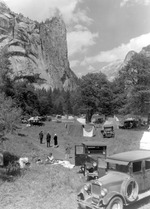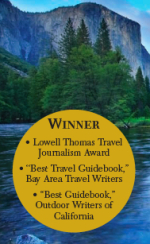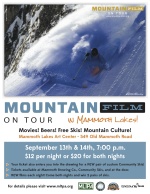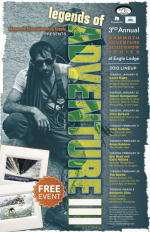Useful, Progressive, Blunt-nosed Mechanical Beetles: John Muir's Notes on Cars in Yosemite
 Camping at Stoneman Meadow, Spring 1927. COURTESY NPS, YNIN THE SPRING OF 2010, with the waterfalls in full gush and snow still on the trees, the Mariposa and Tuolumne County Boards of Supervisors announced a decision to honor John Muir — adventurer, writer, conservationist, Sierra Club founder — by designating a section of CA Highway 132 (from CA 49 in Coulterville to CA 120) the "John Muir Highway."
Camping at Stoneman Meadow, Spring 1927. COURTESY NPS, YNIN THE SPRING OF 2010, with the waterfalls in full gush and snow still on the trees, the Mariposa and Tuolumne County Boards of Supervisors announced a decision to honor John Muir — adventurer, writer, conservationist, Sierra Club founder — by designating a section of CA Highway 132 (from CA 49 in Coulterville to CA 120) the "John Muir Highway."
A formal dedication ceremony had been arranged, to feature John Muir’s great grandson, Bill Hanna, and famed John Muir impressionist, Lee Stetson.
"Personally," wrote Loyd Schutte, of the Yosemite Blog, "I think naming a road 'in honor' of a man who fought so hard against the destruction and urbanization of wild places is in poor taste and a shameless media ploy."
"I agree it's ironic," wrote Yosemite videographer Steven Bumgardner, "but I don't remember JM ever complaining about roads. He wasn't anti-development. He just wanted city folk to go to the country every once and a while."
So what did old John O' the Mountains, the father of the American Conservation movement, think of cars and roads? Well, it's not so cut and dried. Fact is, as prescient as he was, he may not have anticipated the extent to which the automobile would take over American culture — and the park he had fought so hard to create and protect.
Here's a note Muir wrote to Howard Palmer of the American Alpine Club in 1912, summarizing discussions at the National Parks Conference the previous October, on whether or not to allow cars in Yosemite and what sort of development might be needed in order to accomodate all those visitors who, in Muir's words, "have to be rolled on wheels with blankets and kitchen arrangements."
Martinez, Cal.
December 12, 1912
Mr. Howard Palmer:
Secretary American Alpine Club
New London, Conn.
Dear Sir:
At the National Parks conference in Yosemite Valley last October, called by the Honorable Secretary of the Interior, comparatively little of importance was considered. The great question was, "Shall automobiles be allowed to enter Yosemite?" It overshadowed all others, and a prodigious lot of gaseous commercial eloquence was spent upon it by auto-club delegates from near and far.
The principal objection urged against the puffing machines was that on the steep Yosemite grades they would cause serious accidents. The machine men roared in reply that far fewer park-going people would be killed or wounded by the auto-way than by the old prehistoric wagon-way. All signs indicate automobile victory, and doubtless, under certain precautionary restrictions, these useful, progressive, blunt-nosed mechanical beetles will hereafter be allowed to puff their way into all the parks and mingle their gas-breath with the breath of the pines and waterfalls, and, from the mountaineer's standpoint, with but little harm or good.
In getting ready for the Canal-celebration visitors the need of opening the Valley gates as wide as possible was duly considered, and the repair of roads and trails, hotel and camp building, the supply of cars and stages and arrangements in general for getting the hoped-for crowds safely into the Valley and out again. But the Yosemite Park was lost sight of, as if its thousand square miles of wonderful mountains, cañons, glaciers, forests, and songful falling rivers had no existence.
In the development of the Park a road is needed from the Valley along the upper cañon of the Merced, across to the head of Tuolumne Meadows, down the great Tuolumne Cañon to Hetch-Hetchy valley, and thence back to Yosemite by the Big Oak Flat road. Good walkers can go anywhere in these hospitable mountains without artificial ways. But most visitors have to be rolled on wheels with blankets and kitchen arrangements.
Of course the few mountaineers present got in a word now and then on the need of park protection from commercial invasion like that now threatening Hetch-Hetchy. In particular the Secretary of the American Civic Association and the Sierra Club spoke on the highest value of wild parks as places of recreation, Nature's cathedrals, where all may gain inspiration and strength and get nearer to God.
The great need of a landscape gardener to lay out the roads and direct the work of thinning out the heavy undergrowth was also urged.
With all good New Year wishes, I am Faithfully yours
John Muir













 April 30, 2010
April 30, 2010
Reader Comments (4)
At the heart of this designation of a road to honor Muir is an effort to provide an ecologically friendly way to bring Muir's experience during his first journeys to Yosemite Valley to life for visitors. Any one who has had the soulful experience, as Muir first wrote about in My First Summer in the Sierra, of physically being awed and overwhelmed by the power, presence and beauty of the natural world found in the Range of Light, understands the importance of sharing it. Muir certainly did. That is probably why he wrote about it, cheered on tourist visits to the national parks and even commented that "wild trees" needed to make room for "orchards and cornfields" in some cases Wilderness Warrior (http://www.amazon.com/Wilderness-Warrior-Theodore-Roosevelt-Crusade/dp/0060565314) by Douglas Brinkley p. 292). The goal of the project is to present opportunities for this experience in a way that coincides with a geotourism approach which is healthy for the environment and the communities along the route.
My first recommendation to those who have questions regarding why this route was designated as John Muir Highway would be to read the FAQ section found at http://www.JohnMuirHighway.net and also understand what Peter and Donna Thomas have accomplished in their book Muir Ramble Route (http://www.amazon.com/Muir-Ramble-Route-Peter-Thomas/dp/0982427662). The next step would be to read Muir more thoroughly to comprehend his feelings and philosophy as the owner of a winery, friend of a railroad tycoon, father and a man who also loved and shared his life with many people who did not inhabit the wilderness he fought to protect. It might also be helpful to look out at your yards in your suburb neighborhood and, if you see lawns instead of wilderness, read Bill McKibben's book Deep Economy (http://www.amazon.com/Deep-Economy-Wealth-Communities-Durable/dp/0805087222) and start replacing grass with vegetables and fruit trees.
Finally, and especially for those who love and admire Muir from their perch in an urban or suburban area after taking trips to the wilderness, reach out in an attempt to grasp what you don't understand. If you have never had direct responsibility for a significant tract of undeveloped land as your own personal property, you probably don't have any reasonable way to extrapolate how the stewardship of that land entails responsibilities that bind admiration for John Muir beside the love of people who are living in rural areas and struggling to take care of their land and families. It is my belief that to imply that Muir would not be inclined favorably toward geotourism as an ecologically friendly way to enrich visitors knowledge of the natural world experientially while helping to sustain rural lifestyles is to not understand Muir the man.
I hope that the discussion of this topic can proceed with participants taking the necessary time to do their homework on this question, see the wide array of Muir scholars, family and admirers who support the project and start with a more complete basis for their comments. If you live in an urban or suburban area you may want to consider that your real attachment to the land is in need of a reality check that goes beyond periodic visits to the wilderness. I know, in my case, that living in a National Forest while owning a piece of private property has humbled me and nurtured a greater appreciation for both the people and the natural systems my wife and I have been responsible for over the past 9 years. BTW, there are already other roads named after John Muir (in Kentucky, for example).
I can't tell you how much I appreciate your taking the time to respond to this--and in such a thoughtful and incisive manner. I find myself a little too often in the uncomfortable role of provocateur on subjects like these, where I feel somehow the ironies or complexity of our approaches to the world and our often misguided stewardship of it, have been glossed over in one way or another--or simply avoided. And too often, I fear, especially when I'm critical of some marketing department or chamber of commerce or hospitality conglomerate, and can't (or don't) take the time to develop a complete argument, it comes off as little more than the half-baked rantings of some little shit.
Somehow John Muir was able to describe the arguments of auto club members as "a prodigious lot of gaseous commercial eloquence," and we respect his point--or at least listen to it. Write something like that on Facebook (or quote it directly) and you're likely to piss off some of your "friends" or "fans."
Anyway, thanks for taking it head-on. Sometimes I think, in this crazy age we live in, of speed and artificial connections and deeply diluted personal responsibility, and disengagement from the particular chemical qualities of soil, and blind reverence, etc., etc., of the many things we've lost along the way, one is the art or ability or desire or courage or whatever it takes... to engage with each other (and the systems we're complicit in) frankly and critically. Anyway, that's a much larger conversation.
Bottom line, I agree: reality checks are constantly in order for all of us. Whether we live deep in the urb or way out on the fringes, it's easy to fall into ivory-tower perspectives. From up here at 8,500 feet, near the edge of what we call the John Muir Wilderness, from my quarter acre of sloping pumice and red fir ever and fitfully eroding away from a strip of county-built asphalt named after, yes, John Muir, and looking out over an ersatz village where a multi-national development corporation (now bankrupt) was recently invoking John Muir in the service of selling condominiums, I have grown wary of the impulse to give it--whatever it is--John Muir's name and thereby call it good.
Oh and thank you for helping to raise Brinkley and McKibben to the top of the stack. And I can't wait to see the Thomas' book--for three seasons I've been dreaming of walking with them (and Muir) through wind farms and cotton fields and foreclosed subdivisions... And honestly, I do wish I could sneak over the pass this weekend to witness the proceedings.
Cheers,
dp